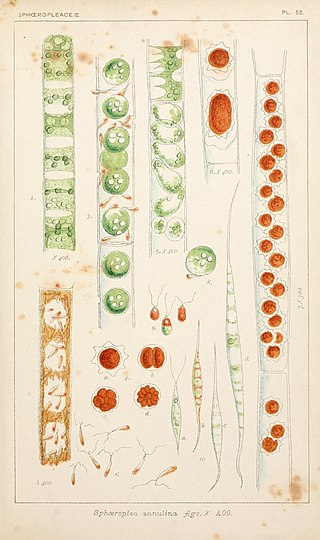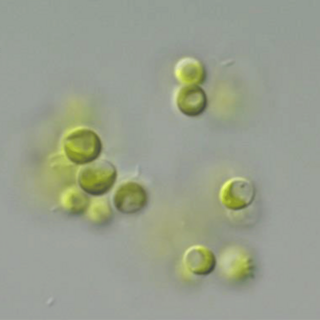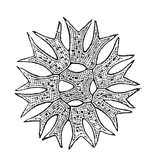
The Chlorophyceae are one of the classes of green algae, distinguished mainly on the basis of ultrastructural morphology. They are usually green due to the dominance of pigments chlorophyll a and chlorophyll b. The chloroplast may be discoid, plate-like, reticulate, cup-shaped, spiral- or ribbon-shaped in different species. Most of the members have one or more storage bodies called pyrenoids located in the chloroplast. Pyrenoids contain protein besides starch. Some green algae may store food in the form of oil droplets. They usually have a cell wall made up of an inner layer of cellulose and outer layer of pectose.

Chlorophyta is a taxon of green algae informally called chlorophytes. The name is used in two very different senses, so care is needed to determine the use by a particular author. In older classification systems, it is a highly paraphyletic group of all the green algae within the green plants (Viridiplantae) and thus includes about 7,000 species of mostly aquatic photosynthetic eukaryotic organisms. In newer classifications, it is the sister clade of the streptophytes/charophytes. The clade Streptophyta consists of the Charophyta in which the Embryophyta emerged. In this latter sense the Chlorophyta includes only about 4,300 species. About 90% of all known species live in freshwater. Like the land plants, green algae contain chlorophyll a and chlorophyll b and store food as starch in their plastids.

The Ulvophyceae or ulvophytes are a class of green algae, distinguished mainly on the basis of ultrastructural morphology, life cycle and molecular phylogenetic data. The sea lettuce, Ulva, belongs here. Other well-known members include Caulerpa, Codium, Acetabularia, Cladophora, Trentepohlia and Monostroma.

Neochloridaceae is a family of green algae in the order Sphaeropleales.

Selenastraceae is a family of green algae in the order Sphaeropleales. Members of this family are common components of the phytoplankton in freshwater habitats worldwide. A few species have been found in brackish and marine habitats, such as in the Baltic Sea.

Sphaeropleaceae is a family of green algae in the order Sphaeropleales.

Ankistrodesmus is a genus of green algae in the family Selenastraceae. It is one of the most common types of phytoplankton in freshwater habitats around the world.

Bracteacoccus is a genus of green algae, the sole genus of the family Bracteacoccaceae. It is a terrestrial alga commonly found in soils, from the tropics to the poles.
Dictyochloris is a genus of green algae in the class Chlorophyceae. It is the sole genus of the family Dictyochloridaceae. It is commonly found in terrestrial and subaerial habitats.

Dictyosphaerium is a genus of green algae, in the family Chlorellaceae. It occurs in freshwater habitats around the world and is planktonic.

Golenkinia is a genus of green algae first described in 1894 by Robert Chodat. The genus is named for the Russian phycologist Mikhail Iljitsch Golenkin. Golenkinia species live in fresh water and are found around the world.

Mychonastes is a genus of green algae, specifically of the Chlorophyceae. It is the sole genus of the family Mychonastaceae.

Parapediastrum is a genus of green algae in the family Hydrodictyaceae. It is fairly common in freshwater regions throughout the world.

Pediastrum is a genus of green algae, in the family Hydrodictyaceae. It is a photoautotrophic, nonmotile coenobial green alga that inhabits freshwater environments.
Pseudomuriella is a genus of green algae, specifically of the class Chlorophyceae. It is the sole genus of the family Pseudomuriellaceae. It is a terrestrial alga that inhabits soils.

Pseudopediastrum is a genus of green algae in the family Hydrodictyaceae. It is very common in freshwater regions throughout the world.

Selenastrum is a genus of green algae in the family Selenastraceae. It is common in freshwater habitats around the world. Most species prefer temperate or warm-temperate waters.

Stauridium is a genus of green algae in the family Hydrodictyaceae. It is very common in freshwater regions throughout the world.

Characiaceae is a family of green algae in the order Sphaeropleales. It contains epiphytic or planktonic algae that are unicellular or colonial. The cells are heteropolar, with basal and apical ends having different shapes. The daughter cells are often retained in the cell wall of the old mother cell, whose cell wall becomes gelatinized.
Bracteamorpha is a genus of green algae in the order Sphaeropleales, and is the only genus in the family Bracteamorphaceae. It contains a single species, Bracteamorpha trainorii.

















